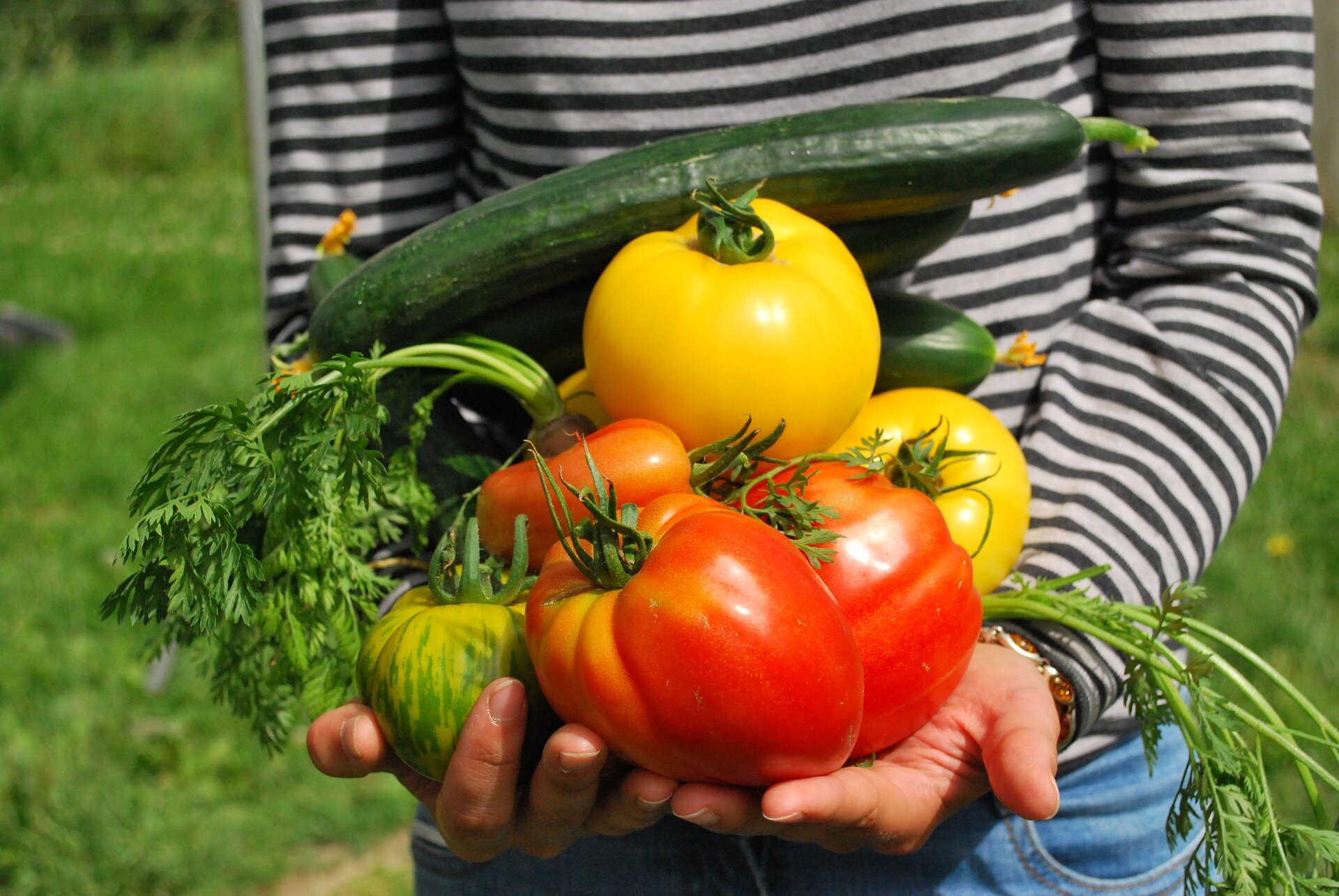Know the the “no till, no dig, no pull rule.” Avoid pulling out crops by the roots. Know the tricks for the biggest harvest. Allow nature to improve the soil. Stop and think before you harvest. Think about how you will cook, store or share the harvest.
Tricks for the biggest harvest
Harvest from the same plant as long as it is producing. Don’t remove healthy prolific plants too soon.
Encourage growth by frequently picking salad greens, tomatoes, beans, peppers, cucumbers, squash, herbs, etc. Harvest frequently the large leaves from leafy green veggies like spinach, lettuce, kale and swiss chard so pests don’t damage them.
Harvest outer leaves of leafy greens to make room for airflow between neighboring plants and to encourage the plant to produce more foliage.
Learn to recognize when a plant is past its prime. Aging plants lose taste and take up precious space.
Stop and think before you harvest
Avoid pulling out crops by the roots. You can undo all the great work you’ve done building up your soil if you don’t give some thought to the root zone or Rhizosphere which includes the roots and everything that surrounds them in the soil. Soil microorganisms interact with a host of chemicals released by plant roots. Any harsh pulling of plants without sensitivity to its roots can upset the soil micro-organisms.
Pulling a plant out by its roots interferes with bacterial colonies and fungal networks. Think of tiny soil structures as invisible towns and cites that the microflora (fungi and bacteria) build and live in. Maintain maximum soil health by leaving the micro-organisms attached to the roots undisturbed.
The “no till, no dig, no pull rule” is an essential part of the Deep Roots innovative growing method. If you avoid interference in the lives of soil fungi and bacteria they will be healthier and happier. They will do a better job of transporting essential nutrients and substances to the plant’s roots. Huge populations of microflora make the critical difference for growing super-healthy plants.
Allow nature to improve the soil. Avoid any digging except for a seedling hole or a furrow for planting seeds. Although traditional farmers and gardeners turn over their soil every season, modern soil scientists now know that digging destroys the soil structures that build up over time which greatly harms the health of the soil.
Pull out roots for only root veggies. Pull out root veggies like carrots and beets when the top peeks out from the soil and they are easy to pull out. For non-root veggies leave the roots in the soil undisturbed and cut the stem close to the ground. Roots supply critically important food for soil microbes. The exception to this rule is harvesting root crops like beets, onions, carrots, garlic, radishes, etc.
Add organic materials like compost and worm castings to the top of the soil. Worms, bugs, plant roots and weather will mix it in for us. But at least you can add organic material when necessary.
Storing your harvest
Think about how you will cook, store or share the harvest. Make a list and research how to use and store your harvest – recipes, freezing, canning, fermenting, drying, storing in sand, storing in a basement, “vacuum sealing” before freezing, and more.
Store leafy greens for a few days in a tight closing plastic bag with all the air squeezed out.
Chop the leafy greens before freezing in tightly closed plastic bags. Freeze in small bags that will be the right amount for a meal.
Freeze cooked foods like stews, smoothies and soups in jars with wide-mouth jars. Leave a half to one inch empty at the top so the food can expand as it freezes. If there is no space at the top the jar could crack.
Fermented foods can be stored for many months at room temperature. There are lots of YouTube videos and online courses on how to ferment many types of foods.
A “vacuum sealer” is a counter-top appliance that allows you to freeze your harvest in small plastic bags for longer and also compresses some foods into a smaller space. Whether you buy in bulk, freeze small portions for meal prep or hunt, vacuum sealing helps most food from going stale as quickly as it would in a non-airtight container. It also helps prevent freezer burn, which affects taste and texture. There are many brands of vacuum sealing machines.
An inexpensive chest-style freezer that opens from the top in storage room or basement makes harvesting and storing food faster and easier.
Store carrots in the ground during winter. Leaving unharvested carrots and parsnips in the ground over winter makes them sweeter.
Canning food in Mason Jars allows you to store food without freezing or refrigerating. It takes time and skill. Find out how to do do home canning at the National Center for Home Food Preservation.
Our Innovative Food Gardening Method
Learn more in our two recently revised blog posts.
Our online store
See our online store for details about prices, ordering and delivery of raised beds, compost, worm castings and more. Please contact our customer support team before placing an order online so we can assist you with the details and answer your gardening questions.
QUESTIONS? COMMENTS?
Contact us at (708) 655-5299 or support[at]deep-roots-project.org.
Stay in touch
Please leave your cell phone number when you sign up for our eNewsletter, if you want text message announcements now and then.
Donations help us provide organic kitchen gardening education to individuals, organizations, and entire communities. Thank you in advance for contributing to our community and for sharing our website and blog with friends and family.


